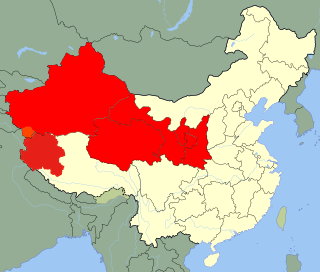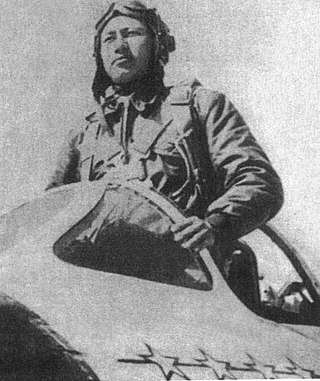
The People's Liberation Army Air Force, also referred to as the Chinese Air Force (中国空军) or the People's Air Force (人民空军), is an aerial service branch of the People's Liberation Army, the regular armed forces of the People's Republic of China. The PLAAF was officially established on 11 November 1949 and it is composed of five branches: aviation, ground-based air defense, radar, Airborne Corps and other support elements.

The Guangzhou Military Region was from 1955 to 2016 one of the People's Liberation Army PLA Military Regions, located in the south of the People's Republic of China. In May 1949, the Central China Military Region (MR) was formed. In March 1955, it was divided into two, the Guangzhou MR and the Wuhan Military Region. When the Wuhan MR was disbanded in August 1985, its troops stationed around the Hubei province were assigned to the Guangzhou MR.

The Shenyang Military Region was one of seven military regions for the Chinese People's Liberation Army. It has command and control of military and armed police forces in the three northeast provinces of Jilin, Heilongjiang, and Liaoning, which also form Military Districts. This region is now superseded by the Northern Theater Command.

The Lanzhou Military Region was one of seven military regions in the People's Republic of China. It directed all People's Liberation Army and People's Armed Police forces in Xinjiang, Qinghai, Gansu, Ningxia, Shaanxi, and Ngari Prefecture in northwest Tibet. It was headquartered in Lanzhou in Gansu Province. It is bordered to the south by the Chengdu Military Region, and to the north by Mongolia, the Altai Republic, which is a political subdivision of the Russian Federation, and Kazakhstan. This region is now part of the Western Theater Command due to the military reforms of 2015.
The 7th Fighter Aviation Division is a unit of the Chinese People's Liberation Army Air Force. It is headquartered at Zhangjiakou Air Base in the Beijing Military Region. The unit is equipped with the Chengdu J-7 and Shenyang J-11 fighters. PLA-AF fighter divisions generally consist of about 17,000 personnel and 70-120 aircraft.
The 24th Fighter Aviation Division is a unit of the Chinese People's Liberation Army Air Force. It is headquartered at Yangcun Air Base in the Beijing Military Region. The unit is equipped with J-8 fighters. PLA-AF fighter divisions generally consist of about 17,000 personnel and 70-120 aircraft.
The 1st Fighter Brigade, sometimes called 1st Air Brigade, previously 1st Fighter Division, is a fighter aircraft unit of the Chinese People's Liberation Army Air Force (PLAAF) based at Xianyang in Shaanxi province. Part of the Northern Theater Command Air Force, the brigade was originally established as the first division level formation of the PLAAF, established 19 June 1950. In the Korean War the unit shot down 92 airplanes. It was the first in PLAAF history to fight in air combat, provide close air support, perform night bombing operations and more. It is also the only air brigade of the People's Liberation Army Air Force to participate in five Chinese national day parades. The unit's MUCD is 93056.

Zhang Jihui was the Deputy Commander of the Chinese People's Liberation Army Air Force (PLAAF) and a highly decorated fighter pilot during the Korean War. Zhang joined the PLAAF in 1945 and was one of the first combat pilots trained for the PLAAF. He was later posted at the Chinese 4th Aviation Division, which was also the first Chinese air unit that entered combat during the Korea War. On 10 February 1952, Zhang became famous in China due to the death of American ace Major George Andrew Davis, Jr., and he was credited by the Chinese with shooting down the American ace. Russian sources disputed his claim 40 years later, with different theories as to who might have engaged him and how they might have done it. Zhang claimed a total of four victories during his service in Korea, and he was awarded the title Combat Hero, 1st Class during his service. After the Korean War, Zhang held various commands and became the Deputy Commander of PLAAF in 1973. Outside of his military career, Zhang was also the Deputy Mayor of Yantai.
The 3rd Fighter Aviation Division was a formation of the Chinese People's Liberation Army Air Force (PLAAF). Initially established in 1950. PLAAF fighter divisions generally consist of about 17,000 personnel and 70-120 aircraft. The division is currently headquartered in Wuhu Air Base, Anhui.
The 64th Fighter Aviation Corps was an aviation corps of the Soviet Air Forces. The corps was the parent unit for Soviet interceptor units based in northeastern Manchuria during the Korean War.

The Eastern Theater Command is one of the five theater commands of the People's Liberation Army (PLA), founded 1 February 2016. It replaced the Nanjing Military Region. The command is headquartered in Nanjing.
The 2nd Fighter Division of the People's Liberation Army Air Force is an air formation of the People's Republic of China. It was part of the Guangzhou Military Region Air Force.
The 6th Fighter Division is an air division of the People's Liberation Army Air Force. It is part of the air force component of the Western Theater Command, and formerly part of the Lanzhou Military Region Air Force.
The 4th Aviation Division is a formation of the Chinese People's Liberation Army Air Force (PLAAF). Initially established in 1950, it served in Korea under Commander Fang Ziyi and Commissar Ye Songsheng, flying Mikoyan-Gurevich MiG-15s. It ended its third combat tour in July 1953. It was soon redesignated the 1st Fighter Division.
The 48th Aviation Division was an air division of the Chinese People's Liberation Army Air Force active from 1971-92.

The 8th Bomber Division or 8th Air Division of the People's Liberation Army Air Force (PLAAF) is an air formation of the People's Republic of China (PRC). Today, the 8th Bomber Division is assigned to the Southern Theater Command and operates Xian H-6 bombers. The 8th Bomber Division, the first and longest-serving bomber unit in the PRC, has been deployed in the 1950–1953 Korean War, 1958 Second Taiwan Strait Crisis, 1959 Tibetan uprising, and today conducts deterrence patrols in the South China Sea.

The 10th Bomber Division or 10th Air Division of the People's Liberation Army Air Force (PLAAF) is an air formation of the People's Republic of China (PRC). The 10th Bomber Division has been accorded the honorary titles of "Model Bomber Group" (模范轰炸机大队) and "Red Banner Division" (红旗师) and is the PLAAF's unit of choice to send to international skills competitions.
The 8th Fighter Brigade is a fighter aircraft unit of the People's Liberation Army Air Force. Previously the 8th Fighter Regiment of the 3rd Air Division, the unit serves as part of the Eastern Theater Command Air Force, responsible for conflict in the East China Sea and Taiwan Strait.

The 29th Fighter Division, also called the 29th Air Division was a fighter division of the Chinese People's Liberation Army Air Force (PLAAF) based in Quzhou, Zhejiang province. Headquartered at Quzhou Air Base, the unit was under the control of the Eastern Theater Command Air Force. The 29th operated Sukhoi Su-30MKK, Chengdu J-7H, and Shenyang J-8B aircraft in support of air operations in the East China Sea and Taiwan Strait. As of 2019, the division commander was Xu Xueqiang. Since the near complete abolition of divisions from the PLA command structure around 2017, the previously subordinate 85th and 87th Fighter Regiments of the 29th FD survived as the 85th and 78th Fighter Brigades, respectively.








